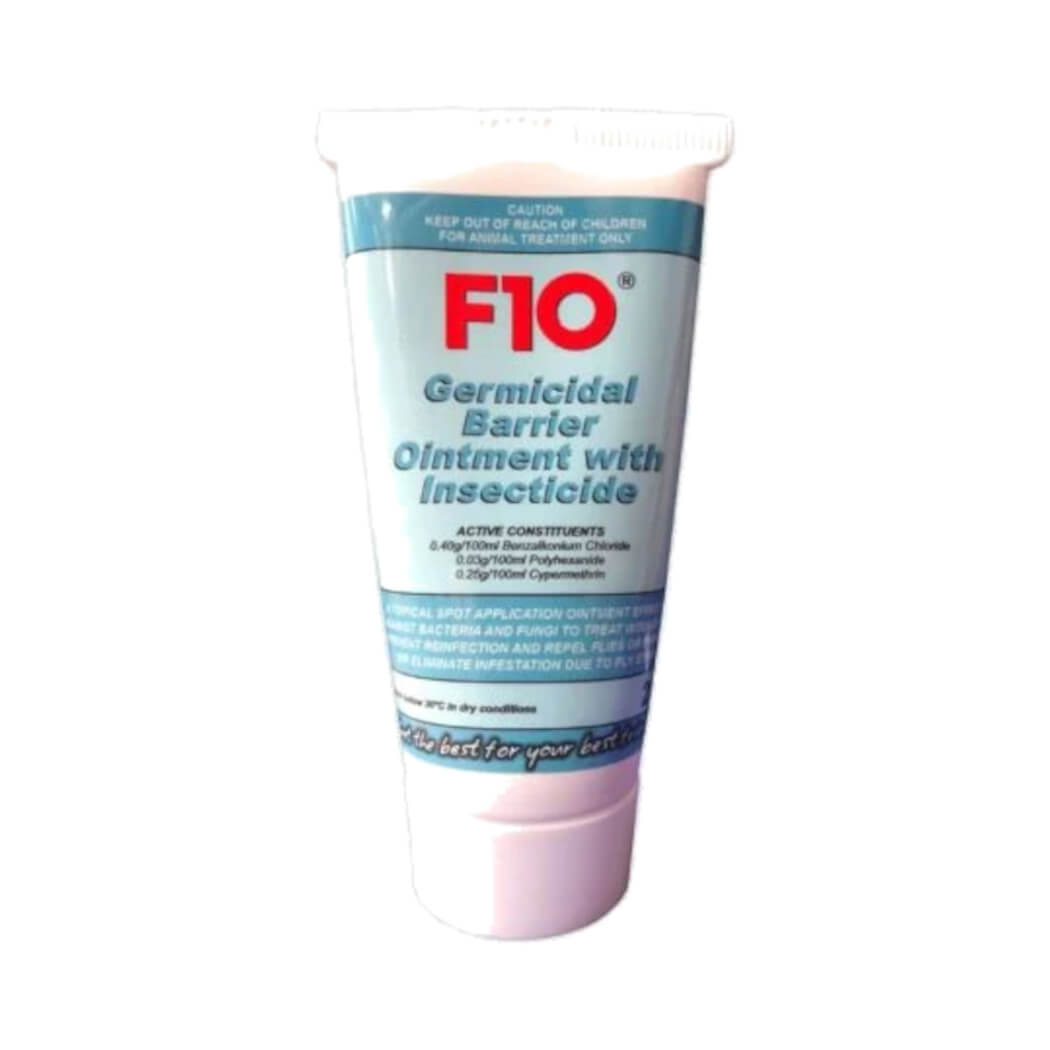Description
F10 Germicidal Barrier Ointment with Insecticide
Registration No.: Act 36/1947 G4048
COMPOSITION
Quaternary ammonium and biguanide compound ………………. 0.44g/100g
Non toxic ampholytic surfactants and sequesterants ……………… 8.81g/100g
Glycol ………………………………………………………………………………………. 83.50g/100g
Lanolin …………………………………………………………………………………….. 4.00g/100g
Non toxic excipients ………………………………………………………………… to balance
Insecticide Additions
Cypermethrin ……………………………………………………………………………………. 0,25%
Piperonyl Butoxide ……………………………………………………………………………. 1,25%
INDICATIONS
An antiseptic preparation effective against bacteria, fungi and viruses. For use in open wound sites caused by e.g. trauma, muelsing, castration, de-budding and de-homing. Also for abscesses, foot rot, dart wound, de-gloving injuries as well as over primary closure sites.
It incorporates an insecticide to repel from wound sites such as biting flies and ticks. It is effective to eliminate infestations due to fly strike (the larvae migrate out of the wound without the need for mechanical elimination) whilst at the same time creating an effective antiseptic barrier and effective repellent to further fly strikes.
ANTIMICROBIAL ACTION
The antimicrobial action of the preparation is based upon the proprietary branded F10 compound. The mechanism of action of F10 is derived from those of each component taken separately, in addition to those due to the additive synergistic action of all components combined. At the concentrations in the product F10 has been assessed as giving a >log5 reduction in microbial counts against gram positive and gram negative bacteria; fungi, yeasts and moulds; enveloped and non-enveloped viruses; bacterial and fungal spores. The group of keratinophylic fungi is very large, but only two genera, know as dermatophytes, are known to cause disease (“ringworm”) in animals.
INSECTICIDAL ACTION
The insecticidal action is based upon cypermethrin (a pyrethroid) and aided by piperonyl butoxide. In the testing phases the indicator species used was Lucilia cuprina, a commonly occurring blow fly species. As soon as the larvae were sprayed they immediately began to migrate from the test site and within 30 minutes were dead. Other tests on L.cuprina eggs resulted in a 100% kill. The product was equally effective against adult flies and showed a 77% kill in 15 minutes rising to 100%
within 30 minutes. Cypermethrin is a broad spectrum insecticide and is effective against other insects, e.g. biting flies, fleas, mosquitoes, and ticks.
RESIDUAL ACTION
Residual action tests showed the product was 100% effective after 5 days. Extended field trials demonstrated that the residual action extended well beyond 2 weeks. The product is water soluble and should be re-applied if the animal has been washed or exposed to heavy rain.
TOXICOLOGY
Acute toxicity studies were carried out in accordance with the test requirements as specified by the EPA. All studies were subject to an independent GLP compliance audit.
- Oral toxicity (rats) – >2000 to 5000mg/kg – category III
- Dermal toxicity (rats) – >5000mg/kg – category III
- Dermal irritation (guinea pigs) – Zero at 24 hours (very slight erythema (grade 1) but reversible within 24 hours) – category IV
- Eye irritation (rabbits) – zero at 24 hours (cornea and iris showed no reaction. The eyelids and nictating membranes were graded 1 after 1 hour and wee reversible after 72 hours) – category IV
- Skin sensitization (guinea pigs) – no sensitization.
STABILITY
Shelf life of 3 years.
DOSAGE AND DIRECTIONS FOR USE
Use only as directed.
- Remove all organic material and clean the wound using an approved irrigating solution. Apply a layer of F10 GERMICIDAL BARRIER OINTMENT WITH INSECTICIDE over the total wound site.
- Repeat weekly or as directed by the veterinarian taking care to repeat the cleaning procedure before each application.
- Re-occurring conditions should be treated in conjunction with a complete treatment plan, including antibiotics, as directed by the veterinarian.
- A recommended infection control programme for use in cases of contagious skin infections is shown below.
Replace cap after use.
PRECAUTIONS
- Ingestion: DO NOT induce vomiting. Give milk or water to drink.
- Eye contact: Rinse eyes with water, seek medical advice if necessary.
WARNINGS
- Avoid contact with domestic cats.
- Do not mix with soaps and other chemicals.
- Avoid contact with eyes.
- Keep out of reach of children, uninformed persons and pets.
- Although this remedy has been extensively tested under a large variety of conditions, failure thereof may ensue as a result of a wide range of reasons. If this is suspected, seek veterinary advice and notify the registration holder.
- Cypermethrin is dangerous to fish or aquatic life. Do not contaminate aquaria, fish bowls, ponds or waterways with the insecticidal product.
PRESENTATION
As a semi-solid ointment in 25g tubes, 100g and 500g pots.
IDENTIFICATION
Semi-solid opaque ointment with a pale pink colouring.
STORAGE INSTRUCTIONS
Store below 30ºC in dry conditions.













